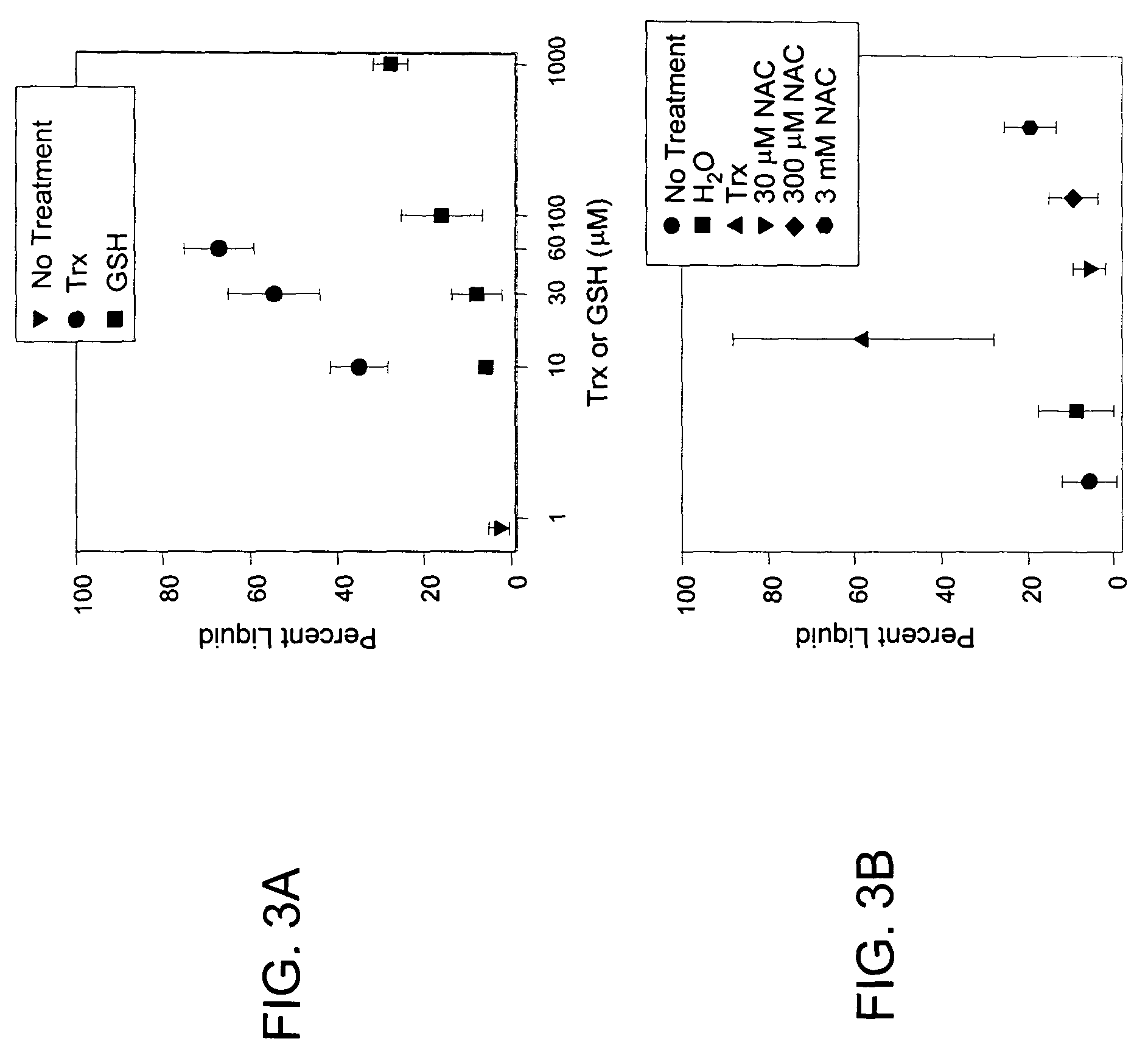Product and process for liquefaction of mucus or sputum
a technology of liquefaction and mucus, which is applied in the field of product and process for can solve the problems of inability to correct cf by gene therapy, inability to achieve sputum viscosity, etc., and achieve the effect of increasing the liquefaction of mucus or sputum
- Summary
- Abstract
- Description
- Claims
- Application Information
AI Technical Summary
Benefits of technology
Problems solved by technology
Method used
Image
Examples
example 1
[0115]The following example describes the effect of the Trx reducing system on release of liquid from CF sputum.
[0116]Due to abnormal ion transport caused by defects in the CFTR gene, airway secretions in CF patients are often desiccated. As a consequence, purulent CF sputum is comprised largely of a rigid and nonflowing biopolymer matrix, often referred to as gel phase, and lesser amounts of soluble, liquid phase. To assess the effect of Trx on the ratios of these two phases in sputum, compaction assay measurements were performed. In a first experiment, equal volumes of sputum samples were treated with 25 μl H2O containing 0, 1, 10, or 30 μM Trx; 0.1 μM TR; and 2 mM NADPH (final concentration). After 20 minute incubation, the liquid fraction of each sample was determined by compaction assay.
[0117]The mean (±SD) percentage of CF sputum present in the liquid phase was 3.5±2.9% prior to Trx exposure (FIG. 1A; values are the mean from 5 independent experiments. *P2O exposed samples). A...
example 2
[0119]The following example demonstrates the reproducibility of compaction assay measurements from Example 1.
[0120]To assess the reproducibility of compaction assay measurements, sputum samples from three different CF donors were separated into aliquots and frozen. Specifically, freshly isolated CF sputum from three different donors (A, B, C) was separated into 275 μl aliquots and frozen. After thaw, aliquots were incubated without treatment, or with H2O, 10 μM Trx (+0.1 μM TR and 2 mM NADPH), or dithiothreitol (DTT, 1 or 5 mM) for 20 minutes and the percent liquid measured by compaction assay. Results obtained from three independent experiments performed on each donor sample were used to evaluate assay reproducibility. On three consecutive days, aliquots were thawed, and treated with water, Trx and its reducing system, dithiothreitol (DTT), or no treatment.
[0121]As shown in FIG. 2, aliquots from donor A that had been treated with no additions or diluent (H2O) had a liquid phase fra...
example 3
[0122]The following example demonstrates that Trx is a more potent sputum liquefaction agent than glutathione or N-acetylcysteine.
[0123]The effectiveness of Trx in liquefying sputum was compared with other monothiol and dithiol reducing agents. Sputum samples were aliquoted and treated with Trx or GSH for 20 minutes and percent liquid determined by compaction assay. Initial compaction assay experiments compared the potencies of the Trx and GSH reducing systems in liquefaction of sputum in the presence of equimolar concentrations of NADPH. Compared to control (no additions), a progressive and significant increase in percent liquid fraction was observed in sputum treated with 10, 30, or 60 μM Trx (FIG. 3A). In contrast, a significant increase in the liquid fraction of sputum was not observed after exposure to GSH at comparable or higher concentrations up to 1 mM. In separate studies, the use of N-acetylcysteine across a range of concentrations (FIG. 3B) also was observed to be less ef...
PUM
| Property | Measurement | Unit |
|---|---|---|
| melting temperatures | aaaaa | aaaaa |
| temperature | aaaaa | aaaaa |
| temperature | aaaaa | aaaaa |
Abstract
Description
Claims
Application Information
 Login to View More
Login to View More - R&D
- Intellectual Property
- Life Sciences
- Materials
- Tech Scout
- Unparalleled Data Quality
- Higher Quality Content
- 60% Fewer Hallucinations
Browse by: Latest US Patents, China's latest patents, Technical Efficacy Thesaurus, Application Domain, Technology Topic, Popular Technical Reports.
© 2025 PatSnap. All rights reserved.Legal|Privacy policy|Modern Slavery Act Transparency Statement|Sitemap|About US| Contact US: help@patsnap.com



